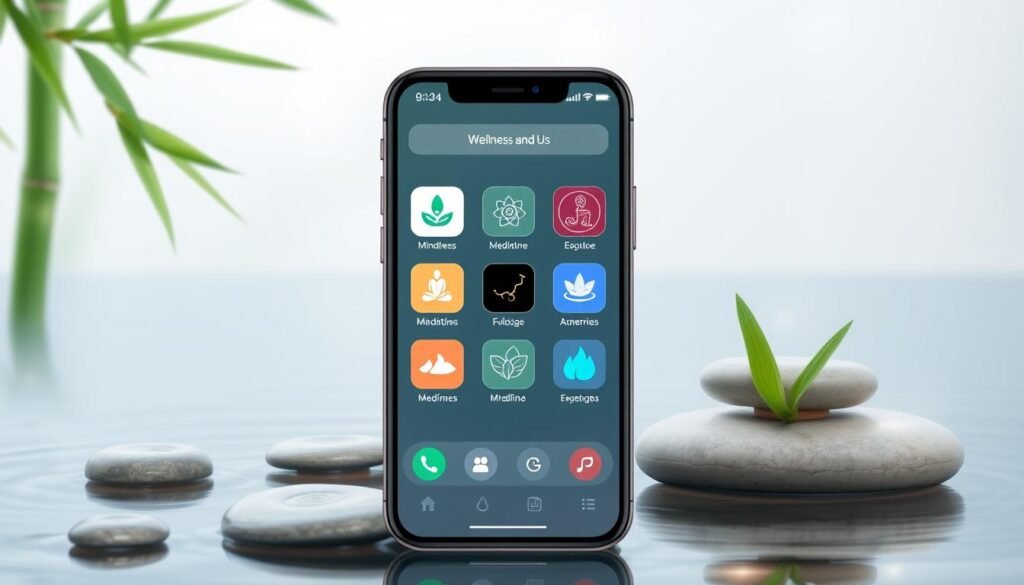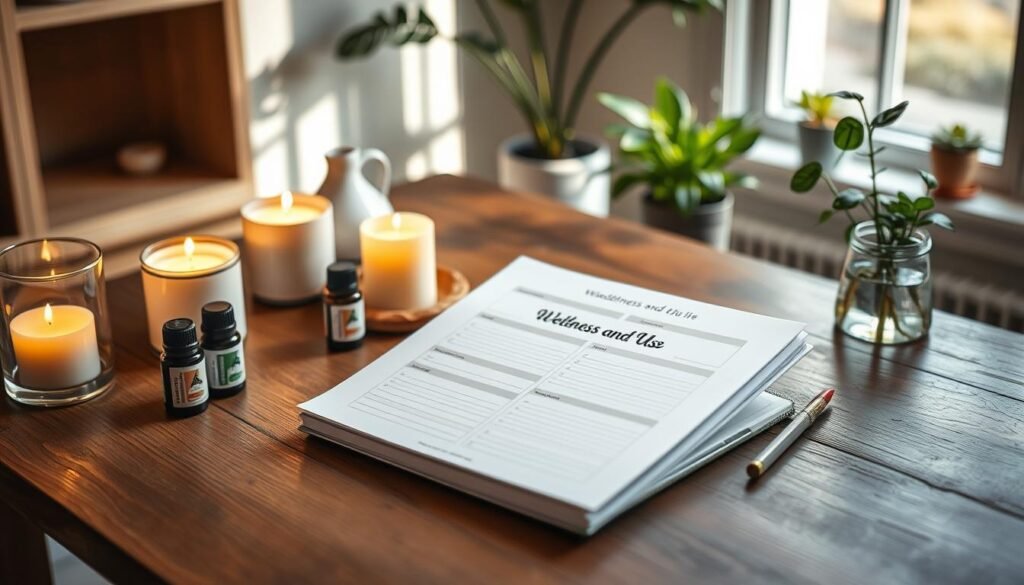Did you know 77% of people often feel stressed physically? Our world moves fast, making peace inside harder to find. But, mindfulness exercises can help fight daily stress and bring back mental balance.
Mindfulness isn’t just a trend. It’s backed by science to help manage emotions and boost well-being. Adding simple mindfulness to your day can change how you face life’s ups and downs.
These exercises are for everyone, no matter your experience. Whether you’re a stressed-out worker, a busy student, or looking to grow personally, these techniques can bring calm and clarity.
Key Takeaways
- Mindfulness exercises can significantly reduce stress levels
- Simple techniques can be practiced anywhere, anytime
- No special equipment or extensive training required
- Scientific research supports the mental health benefits
- Consistent practice leads to long-term emotional resilience
What is Mindfulness?
Mindfulness is a powerful way to change how we see our daily lives. It means paying attention to the present moment without judgment. For beginners, it’s a doorway to personal growth and better emotional health.
Understanding the Concept
Mindfulness is about being fully aware of the present moment. It involves:
- Paying attention to current thoughts and feelings
- Observing sensations without critical evaluation
- Accepting experiences as they are
- Staying grounded in the here and now
“Mindfulness isn’t about perfection, it’s about being present and aware.” – Unknown
Benefits of Practicing Mindfulness
Mindfulness brings many benefits for our minds and bodies:
| Mental Benefits | Physical Benefits |
|---|---|
| Reduced stress | Lower blood pressure |
| Improved emotional regulation | Enhanced immune function |
| Increased focus and concentration | Better sleep quality |
| Enhanced self-awareness | Reduced chronic pain |
For beginners, mindfulness starts with simple, everyday practices. The important thing is to keep practicing and be patient with yourself.
The Science Behind Mindfulness
Mindfulness has caught the eye of scientists all over the world. Studies show it changes our brain and improves our health.
How Mindfulness Transforms Brain Function
Studies using brain imaging show big changes in our brain when we practice mindfulness. It changes the brain’s emotional control centers.
- Reduces activity in the amygdala (stress center)
- Increases gray matter in regions associated with learning and memory
- Enhances neural connectivity between brain regions
“Mindfulness is not about eliminating stress, but changing our relationship with it.” – Dr. Daniel Siegel, Neuropsychiatrist
Research on Stress Reduction through Mindfulness
Many studies prove mindfulness is great for managing stress. People who practice mindfulness often feel less stressed and more emotionally strong.
| Research Focus | Key Findings |
|---|---|
| Cortisol Levels | Significant reduction in stress hormone |
| Immune Function | Enhanced immune system response |
| Psychological Well-being | Decreased anxiety and depression symptoms |
Knowing the science behind mindfulness helps us practice with confidence. It’s backed by solid research and brain science.
Simple Breathing Exercises
Breathing is a powerful tool for managing stress and practicing mindfulness exercises. Our daily lives often leave us feeling overwhelmed. But simple mindfulness practices can help restore calm and mental clarity.
Breathing techniques are key to mindfulness practices. They help us connect with our body, reduce anxiety, and find inner peace. By focusing on your breath, you can quickly move from tension to relaxation.
Deep Breathing Technique
Deep breathing is a simple mindfulness exercise that anyone can do. Here’s how:
- Sit comfortably in a quiet space
- Close your eyes and relax your shoulders
- Inhale slowly through your nose for 4 seconds
- Hold your breath for 2 seconds
- Exhale gradually through your mouth for 6 seconds
- Repeat 5-10 times
“Breath is the bridge which connects life to consciousness.” – Thich Nhat Hanh
Box Breathing: How to Practice
Box breathing is another effective mindfulness exercise used by professionals to manage stress. This technique involves equal-length breaths in a square pattern:
- Inhale for 4 seconds
- Hold for 4 seconds
- Exhale for 4 seconds
- Hold for 4 seconds
Regular practice of these breathing techniques can greatly improve your mental well-being. It introduces you to deeper mindfulness practices.
Mindfulness Meditation
Meditation is a powerful way to find inner peace and clear your mind. Guided mindfulness meditation helps beginners explore their inner world. It reduces stress and builds emotional strength.

Starting to meditate can seem scary, but it’s easy with the right steps. Anyone can learn to be more aware and calm.
Quick Guided Meditation for Beginners
A simple guided meditation can make it easy for newbies to start. Just follow these steps:
- Find a quiet, comfy spot
- Sit with your back straight
- Close your eyes and breathe
- Notice thoughts without judging
- Bring your focus back to breathing when your mind drifts
“Meditation is not about stopping thoughts, but recognizing that you are more than your thoughts.” – Unknown
Tips for Effective Meditation
- Start with short 5-10 minute sessions
- Practice regularly, even if it’s just for a few minutes
- Use guided meditation apps for help
- Be kind to yourself
- Make your meditation space peaceful
Remember, meditation gets better with practice. Don’t aim for perfection. Focus on making progress and being kind to yourself.
Body Scan Technique
Mindfulness exercises are great for relaxation and self-awareness. The body scan technique is a powerful practice. It helps people connect with their body and release tension.
Using body scan mindfulness can lower stress and boost mental health. It’s a gentle way to explore your body without judgment.
Understanding the Body Scan
A body scan is a meditation where you focus on your body parts. It aims to increase awareness of physical sensations. This leads to relaxation and clearer thinking.
Step-by-Step Body Scan Method
- Find a quiet, comfy spot to lie down or sit
- Close your eyes and breathe deeply
- Start with your toes, noticing any feelings
- Move your focus up through your body
- Just observe what you feel without changing it
- Take 10-15 minutes for the full scan
“The body scan is a journey of gentle awareness, where you become an observer of your physical experience.” – Mindfulness Expert
Mindfulness exercises, like the body scan, deepen your connection with your body and emotions. Regular practice can reduce anxiety, improve stress handling, and boost self-awareness.
Benefits of Regular Practice
- Reduces physical tension
- Improves emotional control
- Increases body awareness
- Promotes relaxation
- Supports clearer thinking
Remember, body scan techniques get better with practice. Start with short sessions and increase time as you get more comfortable.
Mindful Walking
Mindful walking turns a simple walk into a powerful mindfulness practice. It’s not just exercise. It’s a way to connect your body and mind with the present moment.

Walking mindfully helps reduce stress and boosts awareness. By focusing on each step and breath, you create a moving meditation. This can be done almost anywhere.
Practicing Awareness During Walking
Mindful walking means paying attention to your body and surroundings. Start by noticing these things:
- The sensation of your feet touching the ground
- The rhythm of your breath
- The movement of your body
- Sounds and environmental details around you
Tips for Mindful Walking
To improve your mindfulness while walking, try these tips:
- Find a quiet spot with few distractions
- Walk at a slow, comfortable pace
- Keep your gaze soft and relaxed
- Wear clothes that are comfortable
“Walking is a man’s best medicine.” – Hippocrates
| Walking Style | Mindfulness Focus | Duration |
|---|---|---|
| Indoor Walking | Breath and Step Rhythm | 10-15 minutes |
| Nature Walking | Environmental Awareness | 20-30 minutes |
| Urban Walking | Sensory Perception | 15-20 minutes |
Remember, mindful walking is about the quality of your experience, not how far you go. Start with short walks and gradually increase the time.
Mindfulness in Daily Activities
Mindfulness isn’t just for meditation or yoga. It’s about being aware in everyday moments. Making routine tasks mindful can lower stress and improve well-being.
Practicing mindfulness in daily life keeps you focused on the now. It makes simple tasks a chance for mental clarity and emotional balance.
Being Present While Eating
Mindful eating makes meals a sensory delight. Try these tips:
- Eat slowly and without distractions
- Notice colors, textures, and flavors of food
- Chew deliberately and appreciate each bite
- Pause between bites to breathe and reflect
“Eat with intention, not just habit.” – Zen Proverb
Mindful Cleaning: Turning Chores into Meditation
Household chores can be mindfulness exercises if done with purpose. Focus on the physical sensations and movements:
| Cleaning Task | Mindfulness Focus |
|---|---|
| Washing Dishes | Feel water temperature, notice soap bubbles |
| Sweeping Floor | Observe rhythmic motions, hear broom sounds |
| Folding Laundry | Pay attention to fabric textures, folding patterns |
Remember, mindfulness is about experiencing the present moment fully, without judgment. Each daily activity offers a chance to practice awareness and cultivate inner peace.
Using Mindfulness Apps
In today’s world, technology is a big help for mindfulness. Smartphone apps make meditation easy and fun. They help people relax and focus better.

Technology can really change your mindfulness journey. These apps guide you in meditation. You can practice anywhere, anytime.
Top Mindfulness Apps to Explore
- Headspace: Beginner-friendly guided meditations
- Calm: Stress reduction programs
- Insight Timer: Largest free meditation library
- Waking Up: Science-based mindfulness techniques
Selecting the Perfect Mindfulness App
When picking a mindfulness app, think about these things:
- How easy it is to use
- The variety of meditation sessions
- If it focuses on anxiety
- The cost and subscription options
“The right app can turn meditation into a daily joy.” – Mindfulness Expert
Pro tip: Most apps have free trials. Try different ones to find what works best for you.
Journaling for Mindfulness
Mindfulness journaling is a powerful tool for self-discovery and emotional growth. It combines writing with mindfulness practices. This helps people gain deeper insights into their inner world and grow in self-awareness.
Journaling for mindfulness offers a special way to understand personal experiences and emotional patterns. It lets people have a meaningful conversation with themselves.
Benefits of Mindfulness Journaling
- Reduces stress and anxiety
- Increases emotional intelligence
- Enhances self-reflection
- Promotes mental clarity
- Supports personal growth
Prompts to Get Started
Start your mindfulness journey with these engaging journaling prompts:
- What emotions am I experiencing right now?
- What am I grateful for today?
- What thoughts are currently occupying my mind?
“Writing is a form of therapy; sometimes I wonder how all those who do not write, compose, or paint can manage to escape the madness, melancholia, the panic and fear which is inherent in a human situation.” – Graham Greene
Mindfulness exercises through journaling can change your mental landscape. Start small, be consistent, and watch your self-awareness grow.
| Journaling Frequency | Potential Benefits |
|---|---|
| Daily (5-10 minutes) | Increased emotional regulation |
| Weekly (30 minutes) | Deeper self-reflection |
| Monthly (1 hour) | Comprehensive personal review |
Remember, there’s no perfect way to journal. Your mindfulness journey is unique, and your writing should reflect your authentic experience.
Creating a Mindfulness Routine
Starting a mindfulness practice changes how you see daily life. It might seem hard at first, but with the right steps, anyone can make it a part of their day. This can help reduce stress and clear your mind.

To make a mindfulness routine, you need to commit and use smart strategies. Begin with small steps. Then, slowly add mindfulness to your daily activities.
Setting Time Aside Daily
It’s not about spending hours meditating. Just 5-10 minutes a day can make a big difference in how you feel.
- Choose a consistent time of day
- Start with short 5-minute sessions
- Select a quiet, comfortable space
- Use a timer to track your practice
Integrating Mindfulness into Your Life
Mindfulness isn’t just for sitting in silence. You can be mindful during everyday tasks. This turns simple moments into chances to be present and think deeply.
| Activity | Mindfulness Strategy |
|---|---|
| Morning Coffee | Focus on aroma, temperature, taste |
| Commuting | Notice breathing, observe surroundings |
| Household Chores | Stay present, engage fully with task |
“Mindfulness is not about perfection, but consistent practice.” – Mindfulness Expert
Remember, creating a mindfulness routine is a personal journey. Be patient with yourself and celebrate small victories in your practice.
Overcoming Challenges in Mindfulness
Starting mindfulness exercises for anxiety can be tough, even for those who have tried before. Many face hurdles that make it hard to keep up with mindfulness. It’s key to know these challenges and find ways to beat them for lasting success.
Common Roadblocks in Mindfulness Practice
Mindfulness needs patience and dedication. Common hurdles include:
- Racing thoughts and mental distractions
- Lack of time in busy schedules
- Difficulty maintaining focus
- Feeling frustrated with perceived lack of progress
- Physical discomfort during meditation
Effective Strategies to Stay Committed
To build a strong mindfulness practice, try these practical tips:
- Start Small: Begin with just 5-minute mindfulness exercises for anxiety
- Create a consistent daily routine
- Be kind to yourself during practice
- Use guided meditation apps
- Experiment with different mindfulness techniques
“Mindfulness is not about perfection, but about consistent practice and self-compassion.” – Mindfulness Expert
It’s normal to face challenges in mindfulness. Each hurdle is a chance to learn more and grow mentally. Stay patient, keep an open mind, and practice with kindness.
Final Thoughts on Mindfulness Exercises
Mindfulness exercises are a powerful way to change yourself. By adding these simple practices to your day, you can reduce stress and find emotional balance. Mindfulness is about gentle exploration, not perfection.
Embracing Mindfulness as a Lifestyle
Mindfulness is more than a skill—it’s a way of life. Regular practice changes how you see challenges and stress. It also changes how you interact with the world.
Every moment is a chance to be aware, whether you’re walking, eating, or working.
Encouragement to Start Your Journey
You don’t need special training or gear to start mindfulness. Begin with simple steps like breathing exercises or short meditations. The goal is to be consistent and kind to yourself.
Your brain will adapt, creating new paths for emotional strength and clear thinking. See mindfulness as a way to grow. With time and effort, you’ll find peace, one breath at a time.










































Discussion about this post